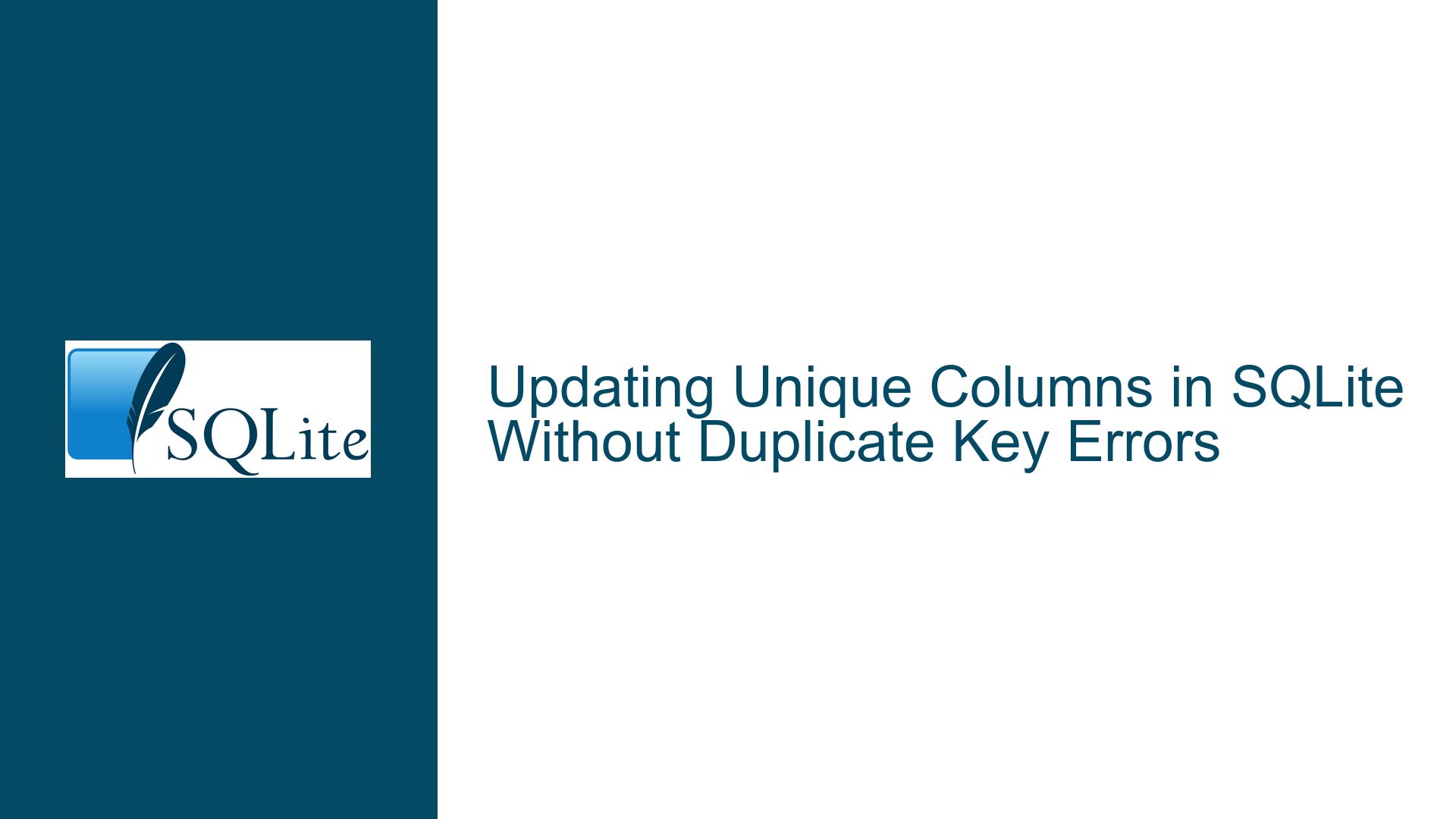Updating Unique Columns in SQLite Without Duplicate Key Errors
Atomic Updates on Unique Columns Leading to Constraint Violations
When working with SQLite, a common challenge arises when attempting to update values in a unique column, such as an id column, in a way that requires reassigning values across multiple rows. For instance, consider a table t1 with a unique column id containing values (1, 2, 3, 4, 5). Executing an update like UPDATE t1 SET id = id - 1 works seamlessly because the reassignment of values does not create conflicts. Each new value is available before the old value is overwritten. However, the reverse operation, UPDATE t1 SET id = id + 1, fails due to a duplicate key error. This occurs because the update attempts to assign a new value that conflicts with an existing value before the old value is cleared.
The core issue lies in the atomicity of the update operation. SQLite processes updates row-by-row, and the uniqueness constraint is enforced immediately after each row is updated. This means that when updating id = 1 to id = 2, the value 2 already exists in the table, triggering a constraint violation. From a logical standpoint, the update operation is intended to be atomic—meaning all values should be reassigned simultaneously without intermediate conflicts. However, SQLite’s row-by-row update mechanism does not support this behavior natively.
This limitation becomes particularly problematic in scenarios where bulk updates to unique columns are necessary, such as renumbering rows or shifting values to accommodate new data. While the issue is most evident with integer-based unique columns, it can also affect other types of unique constraints, including composite keys and foreign key relationships. Understanding the underlying causes and exploring potential solutions is essential for database developers seeking to implement such updates without compromising data integrity.
Row-by-Row Updates and Immediate Constraint Enforcement
The primary cause of the duplicate key error during updates to unique columns is SQLite’s row-by-row update mechanism combined with immediate enforcement of unique constraints. When an UPDATE statement is executed, SQLite processes each row individually, applying the update and enforcing constraints before moving to the next row. This approach ensures data integrity at each step but introduces challenges when updating values that depend on other rows.
For example, consider the update UPDATE t1 SET id = id + 1. The first row processed might have id = 1, which is updated to id = 2. However, id = 2 already exists in the table, causing a duplicate key error. Even though the final state of the table would not violate the unique constraint, the intermediate state during the update does, leading to the failure. This behavior is inherent to SQLite’s design and is not unique to this database system. Many relational databases enforce constraints immediately to maintain consistency and prevent partial updates that could leave the database in an inconsistent state.
Another factor contributing to the issue is the lack of deferred constraint checking in SQLite. Unlike some other database systems, SQLite does not support deferring the enforcement of unique constraints until the end of a transaction. This means that constraints are checked immediately after each row is updated, leaving no room for intermediate states that might temporarily violate constraints but resolve by the end of the transaction. While deferred constraint checking is available for foreign key constraints, it is not supported for unique constraints, further limiting the options for handling such updates.
The interaction between unique constraints and foreign key relationships can also complicate matters. If the unique column is referenced by a foreign key with ON UPDATE CASCADE, the update operation must ensure that the cascading updates do not introduce additional conflicts. This adds another layer of complexity to the problem, as the order of updates and the enforcement of constraints must be carefully managed to avoid errors.
Leveraging UPSERT and Ordered Updates for Conflict-Free Modifications
To address the challenge of updating unique columns without triggering duplicate key errors, developers can leverage SQLite’s UPSERT feature combined with ordered updates. The UPSERT syntax, introduced in SQLite 3.24.0, allows for conditional updates that handle conflicts gracefully. By carefully structuring the update operation and controlling the order in which rows are processed, it is possible to achieve the desired result without violating unique constraints.
The key to this approach is to ensure that updates are performed in an order that avoids intermediate conflicts. For example, when incrementing values in a unique column, processing rows in descending order ensures that each new value is available before the old value is overwritten. This can be achieved using a combination of INSERT ... SELECT and ON CONFLICT DO UPDATE clauses. Here is an example of how this can be implemented:
CREATE TABLE t1(id INTEGER PRIMARY KEY);
INSERT INTO t1 VALUES (1), (2), (3);
-- Perform the update using UPSERT and ordered SELECT
INSERT INTO t1(rowid, id)
SELECT rowid, id + 1
FROM t1
ORDER BY id DESC
ON CONFLICT(rowid) DO UPDATE SET id = excluded.id;
-- Verify the result
SELECT * FROM t1;
In this example, the SELECT statement retrieves rows in descending order of id, ensuring that the highest values are updated first. The ON CONFLICT DO UPDATE clause handles any conflicts by updating the existing row with the new value. This approach effectively simulates an atomic update operation, as the intermediate states do not violate the unique constraint.
Another strategy involves using temporary tables to stage the updates. By copying the data to a temporary table, performing the updates, and then copying the data back to the original table, developers can avoid intermediate conflicts. This method is particularly useful for complex updates involving multiple columns or tables. Here is an example:
-- Create a temporary table with the updated values
CREATE TEMPORARY TABLE temp_t1 AS
SELECT id + 1 AS new_id
FROM t1
ORDER BY id DESC;
-- Replace the original table with the updated values
DELETE FROM t1;
INSERT INTO t1(id)
SELECT new_id FROM temp_t1;
-- Clean up the temporary table
DROP TABLE temp_t1;
-- Verify the result
SELECT * FROM t1;
This approach ensures that the updates are performed in a controlled manner, avoiding conflicts and maintaining data integrity. While it requires additional steps, it provides a reliable solution for scenarios where direct updates are not feasible.
In conclusion, updating unique columns in SQLite without triggering duplicate key errors requires careful planning and the use of advanced features like UPSERT and ordered updates. By understanding the limitations of SQLite’s row-by-row update mechanism and leveraging these techniques, developers can achieve the desired results while maintaining the integrity of their data. Whether through ordered updates, temporary tables, or other creative solutions, the key is to ensure that intermediate states do not violate constraints, allowing the database to transition smoothly to the desired final state.






